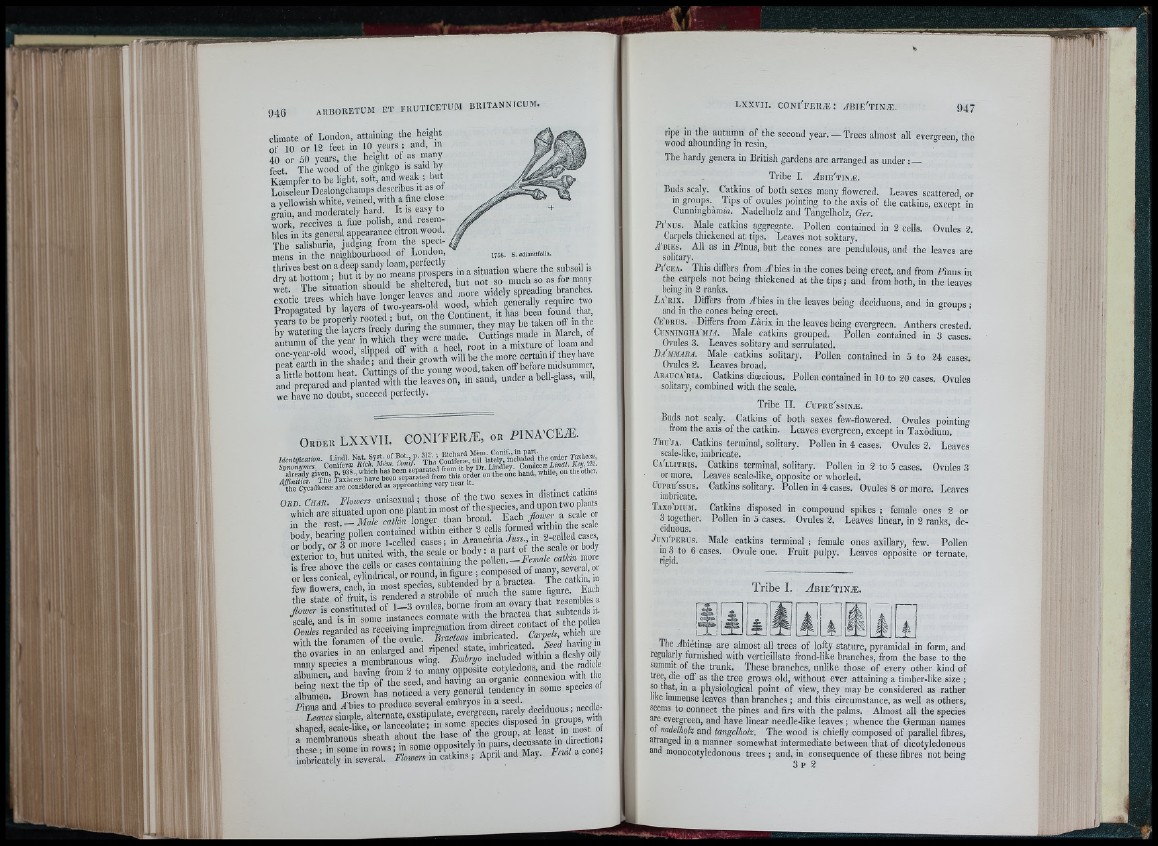
f r 1
climate of London, attaining the height
of 1 0 or 1 2 feet in 1 0 years ; and, jn
40 or 50 years, the height of as many
feet The wood of the gmkgo is said by
Kæmpfer to be light, soft, and weak ; but
Loiseleur Deslongchamps describes it as ot
a vellowish white, veined, with a fine close
grain, and moderately hard. It is easy to
work, receives a fine polish, and resembles
in its general appearance citron wood.
The salisburia, judging from the speci- ,
mens in the neighbourhood of London,
P r o p a g a t e d b y l a y e r s c t e t t e " e e ? f o u n d t h a t ,
t e e t e o l d ^ d , slipped off w^
we have no doubt, succeed perfectly.
1758. S. adiantifòlia.
O r d e r LX X V II . CONF FERÆ, o r PINA'CEÆ.
lUcrt,fixation. Linai, Nat, SysL of B o t p. S'»- ! / r i t « ! m U aS y ri^ Y X i
Svnonvmes. Coniferæ Rick. Mem. xionij. ^ t, riv Dr Lindley. Conaceæ XtnriL Xcy, 232.
t e i s =P ‘to one hand, while, on the other,
' ‘S c^t'adàce* I r e considered ae approaching very near It. _
w É w m m m
W M S ê ê B
• S S S = S S = S .f r ì S B
E 2 ~ S £ £ s s ï s î î “ ^
L x x v n . c o n i ' f e r æ ; «î b i e ' t i n æ :. 9 4 7
ripe in the autumn of the second year. — Trees almost all evergreen the
wood abounding in resin, ’
The hardy genera in British gardens are arranged as under : —
Tribe I. 4 bie'tinje.
Buds scaly. Catkins of both sexes many flowered. Leaves scattered or
in groups.^ Tips of ovules pointing to the axis of the catkins, except in
L.unnmgliaii)!«. Nadelholz and Tangelholz, Ger.
P i ' n u s . Male catkins aggregate. Pollen contained in 2 cells. Ovules 2
Carpels thickened at tips. Leaves not solitary.
4'bies. All as in Pinus, but the cones are pendulous, and the leaves are
solitary.
P i 'c E A . This differs from 4'bies in the cones being erect, and from /'inus in
the carpels not being thickened at the tips ; and from both, in the leaves
being in 2 ranks.
La'bix. Differs from A'bies in the leaves being deciduous, and in groups •
and in the cones being erect. ’
Cedrus. Differs from ià r ix in the leaves being evergreen. Anthers crested.
CuNNiNGHA'MLd. Male catkins grouped. Pollen contained in 3 cases.
Ovules 3. Leaves solitary and serrulated.
D a 'm m a r a . Male catkins solitary. Pollen contained in 5 to 24 cases
Ovules 2 . Leaves broad.
A r a u c a ' r i a . Catkins dioecious. Pollen contained in 10 to 20 cases. Ovules
solitary, combined with the scale.
Tribe II. C u p b e 's s i n a ! .
Bails not scaly. Catkins of both sexes few-flowered. Ovules pointing
from the axis of the catkin. Leaves evergreen, except in Taxòdium.
P h u ' j a . Catkins terminal, solitary. Pollen in 4 cases. Ovules 2 . Leaves
scale-like, imbricate.
Ca 'llitris. Catkins terminal, solitary. Pollen in 2 to .5 cases. Ovules 3
or more. Leaves scale-like, opposite or whorled.
Cd p e e ' s s u s . Catkins solitary. Pollen in 4 cases. Ovules 8 or more. Leaves
imbricate.
T a x o 'd iu a i .
Catkins disposed in compound spikes ; female ones 2 or
3 together,
Pollen in 3 cases. Ovules 2 . Leaves linear, in 2 ranks, de-
ciduous.
dUNT'PERUS. ___
Male catkins terminal ; female ones axillary, few. Pollen
in 3 to 6 cases,
Ovule one. Fruit pulpy. Leaves opposite or ternate,
rigid.
Tribe I. a î b i e ' t i n æ .
The ^bietinfe are almost all trees of lofty stature, pyramidal in form, and
regularly furnished with verticillate frond-like branches, from the base to the
summit of the trunk. These branches, unlike those of every other kind of
tree, die off as the tree grows old, without ever attaining a timber-like size ;
so that, in a physiological point of view, they maybe considered as rather
like immense leaves than branches ; and this circumstance, as well as others,
seems to connect the pines and firs with the palms. Almost all the species
are evergreen, and have linear needle-like leaves ; whence the German names
of nadelhqlz and tangelholz. The wood is chiefly composed of parallel fibres,
arranged in a manner somewhat intermediate between that of dicotyledonous
and monocotyledonous trees ; and, in consequence of these fibres not being
3 p 2
L à